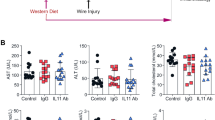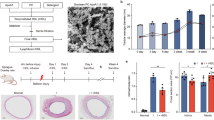Abstract
Although most therapeutic strategies to prevent restenosis are designed to inhibit vascular smooth muscle cell (VSMC) proliferation directly, VSMC proliferation might be indirectly inhibited by re-endothelialization, as endothelial cells secrete antiproliferative and antithrombotic substances. We hypothesized that application of an endothelium-specific growth factor to balloon-injured arteries could accelerate re-endothelialization, thereby attenuating intimal hyperplasia. In this study, we investigated in vivo gene transfer of human HGF that exclusively stimulated endothelial cells without replication of VSMC growth into injured vessels. Transfection of human HGF gene into rat balloon-injured carotid artery resulted in significant inhibition of neointimal formation up to at least 8 weeks after transfection, accompanied by detection of human immunoreactive HGF. Induction of re-endothelialization induced by overexpression of human HGF gene transfer into balloon-injured vessels is supported by several lines of evidence: (1) Administration of HGF vector, but not control vector, markedly inhibited neointimal formation, accompanied by a significant increase in vascular human and rat HGF concentrations. (2) Planimetric analysis demonstrated a significant increase in re-endothelialized area in arteries transfected with human HGF vector. (3) Induction of NO content in balloon-injured vessels transfected with human HGF vector was observed in accordance with the recovery of endothelial vasodilator properties in response to acetylcholine. As endogenous HGF expression in balloon-injured vessels was significantly decreased as compared with normal vessels, the present study demonstrated the successful inhibition of neointimal formation by transfection of human HGF gene as ‘cytokine supplement therapy’ in a rat balloon injury model.
This is a preview of subscription content, access via your institution
Access options
Subscribe to this journal
Receive 12 print issues and online access
$259.00 per year
only $21.58 per issue
Buy this article
- Purchase on Springer Link
- Instant access to full article PDF
Prices may be subject to local taxes which are calculated during checkout





Similar content being viewed by others

References
Gibbons GH, Dzau VJ . The emerging concept of vascular remodeling New Engl J Med 1994 330: 1431–1438
Dzau VJ . The role of mechanical and humoral factors in growth regulation of vascular smooth muscle cells and cardiac myocytes Curr Opin Nephrol Hypertens 1993 2: 27–32
Dzau VJ, Gibbons GH . Endothelium and growth factors in vascular remodeling of hypertension Hypertension 1991 18: (Suppl. III) III–115–III-121
Asahara T et al. Accelerated restitution of endothelial integrity and endothelium-dependent function after phVEGF165 gene transfer Circulation 1996 94: 3291–3302
Asahara T et al. Local delivery of vascular endothelial growth factor accelerates re-endothelialization and attenuates intimal hyperplasia in balloon-injured rat carotid artery Circulation 1995 92: 2793–2801
Asahara T et al. Accelerated restitution of endothelial integrity and endothelium-dependent function after phVEGF165 gene transfer Circulation 1996 94: 3291–3302
Sellke FW et al. Basic FGF enhances endothelium-dependent relaxation of the collateral-perfused coronary microcirculation Am J Physiol 1994 267: H1303–H1311
Nakamura Y et al. A vascular modulator, hepatocyte growth factor, is associated with systolic blood pressure Hypertension 1996 28: 409–413
Nakamura Y et al. Hepatocyte growth factor (HGF) is a novel member of endothelium-specific growth factors: additive stimulatory effect of HGF with basic fibroblast growth factor, but not vascular endothelial growth factor J Hypertens 1996 14: 1067–1072
Matsumoto K, Nakamura T . Emerging multipotent aspects of hepatocyte growth factor J Biochem Tokyo 1996 119: 591–600
Ponzetto C et al. A multifunctional docking site mediates signaling and transformation by the HGF/SF receptor family Cell 1994 77: 261–271
Rosen EM, Nigam SK, Goldberg ID . Scatter factor and the c-met receptor: a paradigm for mesenchymal/epithelial interaction J Cell Biol 1994 127: 1783–1787
Matsumoto K, Nakamura T . Hepatocyte growth factor (HGF) as tissue organizer for organogenesis and regeneration Biochem Biophys Res Commun 1997 239: 639–644
Morishita R et al. Potential role of endothelium-specific growth factor, hepatocyte growth factor, on endothelial damage in diabetes mellitus Diabetes 1997 46: 138–142
Morishita R et al. Role of hepatocyte growth factor in endothelial regulation: prevention of high D-glucose-induced endothelial cell death by prostaglandins and phosphodiesterase type 3 inhibitor Diabetologia 1997 40: 1053–1061
Yo Y et al. Actions of hepatocyte growth factor as a local modulator in the kidney: potential role in pathogenesis of renal disease Kidney Int 1998 53: 50–58
Nakano N et al. Negative regulation of local hepatocyte growth factor (HGF) expression by angiotensin II and transforming growth factor-β in blood vessels: potential role of HGF in cardiovascular disease Hypertension 1998 32: 444–451
Hayashi S et al. Autocrine-paracrine effects of overexpression of hepatocyte growth factor gene on growth of endothelial cells Biochem Biophys Res Commun 1996 220: 539–545
Kaneda Y, Iawai K, Uchida T . Increased expression of DNA cointroduced with nuclear protein in adult rat liver Science 1989 243: 375–378
Morishita R et al. In vivo transfection of cis element ‘decoy’ against NFκB binding site prevented myocardial infarction as gene therapy Nature Med 1997 3: 894–899
Morishita R et al. Single intraluminal delivery of antisense cdc 2 kinase and PCNA oligonucleotides results in chronic inhibition of neointimal hyperplasia Proc Natl Acad Sci USA 1993 90: 8474–8478
Morishita R et al. Intimal hyperplasia after vascular injury is inhibited by antisense cdk 2 kinase oligonucleotides J Clin Invest 1994 93: 1458–1464
Morishita R et al. A novel molecular strategy using cis element ‘decoy’ of E2F binding site inhibits smooth muscle proliferation in vivo Proc Natl Acad Sci USA 1995 92: 5855–5859
Libby P et al. A cascade model for restenosis: a special case of atherosclerosis progression Circulation 1992 86: III–47–III-52
Casscells W . Migration of smooth muscle and endothelial cells: critical events in restenosis Circulation 1992 86: 723–729
Clowes AW, Clowes MM, Fingerle J, Reidy MA . Regulation of smooth muscle cell growth in injured artery J Cardiovasc Pharmacol 1989 14: S12–S15
Chang MW et al. Cytostatic gene therapy for vascular proliferative disorders with a constitutively active form of the retinoblastoma gene product Science 1995 267: 518–522
Chang MW et al. Adenovirus-mediated over-expression of the cyclin/cyclin-dependent kinase inhibitor, p21 inhibits vascular smooth muscle cell proliferation and neointima formation in the rat carotid artery model of balloon angioplasty J Clin Invest 1995 96: 2260–2268
Isner JM et al. Clinical protocol: arterial gene therapy for restenosis Hum Gene Ther 1996 7: 989–1011
Yonemitsu Y et al. Characterization of in vivo gene transfer into the arterial wall mediated by the Sendai virus (hemagglutinating virus of Japan) liposomes: an effective tool for the in vivo study of arterial diseases Lab Invest 1996 75: 313–323
Carmeleit P, Collen D . Molecular analysis of blood vessel formation and disease Am J Physiol 1997 273: H2091–2104
Aoyagi M et al. Localization and effects of hepatocyte growth factor on smooth muscle cells during neointimal formation after balloon denudation Histochem Cell Biol 1999 111: 419–428
George SJ et al. Adenovirus-mediated gene transfer of the human TIMP-1 gene inhibits smooth muscle cell migration and neointimal formation in human saphenous vein Hum Gene Ther 1998 9: 867–877
Dollery CM et al. Expression of tissue inhibitor of matrix metalloproteinases 1 by use of an adenoviral vector inhibits smooth muscle cell migration and reduces neointimal hyperplasia in the rat model of vascular balloon injury Circulation 1999 99: 3199–3205
Matsumoto T et al. Hemagglutinating virus of Japan-liposome mediated gene transfer of endothelial cell nitric oxide synthase inhibits intimal hyperplasia of canine vein grafts under conditions of poor runoff J Vasc Surg 1998 27: 135–144
Morishita R et al. Novel in vitro gene transfer method for study of local modulators in vascular smooth muscle cells Hypertension 1993 21: 894–899
Leyen HVL et al. Gene therapy inhibiting neointimal vascular lesion: in vivo transfer of ec-nitric oxide synthase gene Proc Natl Acad Sci USA 1995 92: 1137–1141
Nakamura T et al. Molecular cloning and expression of human hepatocyte growth factor Nature 1989 342: 440–443
Seki T et al. Organization of the human hepatocyte growth factor-encoding gene Gene 1991 102: 213–219
Nakamura Y et al. Expression of local hepatocyte growth factor system in vascular tissues Biochem Biophys Res Commun 1995 215: 483–488
Yamada A et al. Rapid and sensitive enzyme-linked immunosorbent assay for measurement of HGF in rat and human tissues Biomed Res 1995 16: 105–114
Nakajima M, Toda N . Prejunctional and postjunctional actions of prostaglandins F2 alpha and I2 and carbocyclic thromboxane A2 in isolated dog mesenteric arteries Eur J Pharmacol 1986 120: 309–318
Acknowledgements
We wish to thank Rie Kosai and Michiko Tamakoshi for their excellent technical assistance. This work was partially supported by grants from the Hoan-sya Foundation, the Japan Cardiovascular Research Foundation, a Japan Heart Foundation Research Grant, a Grant-in-Aid from The Ministry of Education, Science, Sports and Culture of Japan.
Author information
Authors and Affiliations
Rights and permissions
About this article
Cite this article
Hayashi, K., Nakamura, S., Morishita, R. et al. In vivo transfer of human hepatocyte growth factor gene accelerates re-endothelialization and inhibits neointimal formation after balloon injury in rat model. Gene Ther 7, 1664–1671 (2000). https://doi.org/10.1038/sj.gt.3301284
Received:
Accepted:
Published:
Issue Date:
DOI: https://doi.org/10.1038/sj.gt.3301284
Keywords
This article is cited by
-
Coronary stents with inducible VEGF/HGF-secreting UCB-MSCs reduced restenosis and increased re-endothelialization in a swine model
Experimental & Molecular Medicine (2018)
-
Inducible HGF-secreting Human Umbilical Cord Blood-derived MSCs Produced via TALEN-mediated Genome Editing Promoted Angiogenesis
Molecular Therapy (2016)
-
The dipeptidyl peptidase-4 inhibitor teneligliptin improved endothelial dysfunction and insulin resistance in the SHR/NDmcr-cp rat model of metabolic syndrome
Hypertension Research (2014)
-
In vivo evaluation of a novel dexamethasone-heparin-double-coated stent for inhibition of artery restenosis and thrombosis
Journal of Materials Science: Materials in Medicine (2011)
-
Effect of nifedipine on endothelial function in normotensive smokers: potential contribution of increase in circulating hepatocyte growth factor
Journal of Human Hypertension (2004)


